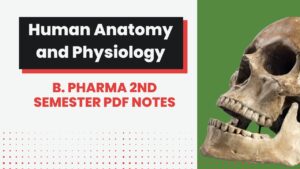Human Anatomy and Physiology II – B. Pharma 2nd Semester PDF Notes

Scope: Human Anatomy and Physiology II is designed to impart fundamental knowledge on the structure and functions of the various systems of the human body. It also helps in understanding both homeostatic mechanisms.
The subject provides the basic knowledge required to understand the various disciplines of pharmacy.
Objectives: Upon completion of this course the student should be able to:
1. Explain the gross morphology, structure, and functions of various organs of the human body.
2. Describe the various homeostatic mechanisms and their imbalances.
3. Identify the various tissues and organs of different systems of the human body.
4. Perform hematological tests like blood cell counts, hemoglobin estimation, bleeding/clotting time, etc, and also record blood
pressure, heart rate, pulse, and respiratory volume.
5. Appreciate the coordinated working pattern of different organs of each system
6. Appreciate the interlinked mechanisms in the maintenance of normal functioning (homeostasis) of the human body.
Course Content:
Human Anatomy and Physiology II Unit I
Nervous system
Organization of nervous system, neurons, neuroglia, classification and properties of nerve fiber, electrophysiology, action potential, nerve impulse, receptors, synapse, neurotransmitters.
Central nervous system: Meninges, ventricles of the brain, and cerebrospinal fluid. Structure and functions of the brain (cerebrum, brain stem, cerebellum), spinal cord (gross structure, functions of afferent and efferent nerve tracts, reflex activity)
Human Anatomy and Physiology II Unit II
Digestive system
Anatomy of GI Tract with special reference to anatomy and functions of the stomach, (Acid production in the stomach, regulation of acid production through the parasympathetic nervous system, pepsin role in protein digestion) small intestine and large intestine, anatomy and functions of salivary glands, pancreas, and liver, movements of GIT, digestion and absorption of nutrients and disorders of GIT.
Energetics
Formation and role of ATP, Creatinine Phosphate, and BMR.
Human Anatomy and Physiology II Unit III
Respiratory system
Anatomy of the respiratory system with special reference to the anatomy of lungs, mechanism of respiration, regulation of respiration
Lung Volumes and capacities transport respiratory gases, artificial respiration, and resuscitation methods.
Urinary system
Anatomy of the urinary tract with special reference to the anatomy of kidney and nephrons, functions of kidney and urinary tract, physiology of urine formation, micturition reflex and role of kidneys in acid-base balance, the role of RAS in kidney and disorders of the kidney.
Human Anatomy and Physiology II Unit IV
Endocrine system
Classification of hormones, mechanism of hormone action, structure and functions of the pituitary gland, thyroid gland, parathyroid gland, adrenal gland, pancreas, pineal gland, thymus, and their disorders.
Human Anatomy and Physiology II Unit V
Reproductive system
Anatomy of the male and female reproductive system, Functions of the male and female reproductive system, sex hormones, physiology of menstruation, fertilization, spermatogenesis, oogenesis, pregnancy, and parturition
Introduction to genetics
Chromosomes, genes, and DNA, protein synthesis, the genetic pattern of inheritance
Human Anatomy and Physiology II (Practical)
Practical physiology is complementary to theoretical discussions in physiology. Practicals allow the verification of physiological processes discussed in theory classes through experiments on living tissue, intact animals, or normal human beings. This is helpful for developing an insight into the subject.
1. To study the integumentary and special senses using specimens, models, etc.,
2. To study the nervous system using specimens, models, etc.,
3. To study the endocrine system using specimens, models, etc
4. To demonstrate the general neurological examination
5. To demonstrate the function of the olfactory nerve
6. To examine the different types of taste.
7. To demonstrate the visual acuity
8. To demonstrate the reflex activity
9. Recording of body temperature
10. To demonstrate positive and negative feedback mechanisms.
11. Determination of tidal volume and vital capacity.
12. Study of digestive, respiratory, cardiovascular systems, urinary and reproductive systems with the help of models, charts, and specimens.
13. Recording of the basal mass index.
14. Study of family planning devices and pregnancy diagnosis tests.
15. Demonstration of total blood count by cell analyzer
16. Permanent slides of vital organs and gonads.
Human Anatomy and Physiology II Recommended Books (Latest Editions)
1. Essentials of Medical Physiology by K. Sembulingam and P. Sembulingam. Jaypee’s brother’s medical publishers, New Delhi.
2. Anatomy and Physiology in Health and Illness by Kathleen J.W. Wilson, Churchill Livingstone, New York
3. Physiological basis of Medical Practice-Best and Tailor. Williams & Wilkins Co, Riverview, MI USA
4. Textbook of Medical Physiology- Arthur C, Guyton, and John.E. Hall. Miamisburg, OH, U.S.A.
5. Principles of Anatomy and Physiology by Tortora Grabowski. Palmetto, GA, U.S.A.
6. Textbook of Human Histology by Inderbir Singh, Jaypee brothers medical publishers, New Delhi.
7. Textbook of Practical Physiology by C.L. Ghai, Jaypee Brothers medical publishers, New Delhi.
8. Practical workbook of Human Physiology by K. Srinageswari and Rajeev Sharma, Jaypee’s brother’s medical publishers, New Delhi.
Reference Books:
1. Physiological basis of Medical Practice-Best and Tailor. Williams & Wilkins Co, Riverview, MI USA
2. Textbook of Medical Physiology- Arthur C, Guyton, and John. E. Hall. Miamisburg, OH, U.S.A.
3. Human Physiology (vol 1 and 2) by Dr. C.C. Chatterrje, Academic Publishers Kolkata

1 thought on “Human Anatomy and Physiology II – B. Pharma 2nd Semester PDF Notes”
Comments are closed.